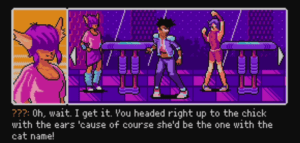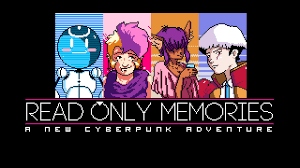2064 Read Only Memories (2064) is a mystery game developed by Midboss. The game has seen ports to most major consoles and mobile, but it was originally released for computers, which is how I played it. It is best suited for young adults and older, as it includes some profanity and some graphic scenes (e.g. inspecting a dead body). The game is set in the future city of Neo San Francisco in the year 2064. You play as a down-on-their-luck journalist seeking to unravel the mystery of their old friend’s disappearance, aided by a robot sidekick named Turing. The game is deeply interesting in exploring the social and political issues its future society faces as a mirror for issues plaguing our own society. As such, it confronts the player with their own biases, asking for a level of vulnerable engagement that I have seen in very few other games. It accomplishes this by challenging the player’s assumptions about its characters and world. However, I find the game misses the opportunity to weave its narrative into its gameplay.
Now, the game does set up a core gameplay loop that successfully complicates the player’s understanding of the world by subverting their expectations. Mechanically, players have a small set of interactions they are able to perform with characters and objects in the world. These are: inspect, use objects on, touch, and talk. Because dialogue progresses the story, players will want to inspect everything in a scene first, to have the most information possible before talking to characters and potentially making story-altering decisions. This creates a loop of entering a scene, observing everything in the environment, then talking to important characters. Players therefore develop assumptions about characters by inspecting them, then those assumptions are challenged by talking with them. Most memorably for me was a moment where I was tasked with finding a character named Tomcat in a bustling bar. One patron was a woman with cat ears and fur, so my first impulse was to approach her and ask whether she was Tomcat. She was incredibly offended and chewed me out for my assumption. Now, for context, in the world of 2064 people with genetic modifications are a marginalized group, similar to how transgender people are a marginalized group today. The game mirrored real-world power structures and challenged my expectations for aligning with these power structures. It does this in many small ways, and I feel that it really supports the story it is trying to tell about social upheaval.



However, I think the game misses the chance to weave its narrative into other aspects of its gameplay. For one, the game progresses almost entirely linearly. Each scene is self-contained, and progressing through a scene only requires the player to interact with game elements in that scene. At most, I was given a choice of which of two leads to follow first, which actually amounted to choosing which of two scenes to play through first. This results in an experience akin to a visual novel, where the player has little, if any, agency over the direction of the story.
The “visual novel” feeling is heightened by the story progressing primarily through dialogue. The game has some environmental details, but players are not asked to piece together a story from these environmental details. Rather, they provide context for interactions between the player and NPCs. For example, at one point in the game I stepped into a soda fountain to chat with the owner. The walls of the building were decorated with posters that, upon inspection, were said to be movie and anime posters. When I talked to the soda fountain owner, they pointed out these posters, commenting that they were a big fan of “old school entertainment”. The environmental elements were redundant, since I did not learn anything from them that I did not already learn from dialogue.
This is a microcosm of a larger pattern in the game – players have few opportunities to miss out on information, making the experience relatively absent of challenge in a way that can feel un-game-like. I never got a sense that dialogue trees had a dead end. I was almost always given the opportunity to backtrack and ask as many questions as I wanted. This is not necessarily negative. For one, missing out on information in a narrative-focused game can be a frustrating experience that discourages players from finishing the game. Additionally, it complements the lack of environment storytelling to create an experience reminiscent of cozy games. There is not much mental or physical challenge to uncovering the mystery, which makes it a relatively relaxing play. I found the experience of playing this game like reading a good book or watching a good show, but not necessarily like playing an engaging game.



